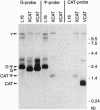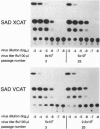Abstract
A reverse genetics approach was applied to generate a chimeric nonsegmented negative strand RNA virus, rabies virus (RV) of the Rhabdoviridae family, that expresses a foreign protein. DNA constructs containing the entire open reading frame of the bacterial chloramphenicol acetyltransferase (CAT) gene and an upstream RV cistron border sequence were inserted either into the nontranslated pseudogene region of a full-length cDNA copy of the RV genome or exchanged with the pseudogene region. After intracellular T7 RNA polymerase-driven expression of full-length antigenome RNA transcripts and RV nucleoprotein, phosphoprotein and polymerase from transfected plasmids, RVs transcribing novel monocistronic mRNAs and expressing CAT at high levels, were recovered. The chimeric viruses possessed the growth characteristics of standard RV and were genetically stable upon serial cell culture passages. CAT activity was still observed in cell cultures infected with viruses passaged for more than 25 times. Based on the unprecedented stability of the chimeric RNA genomes, which is most likely due to the structure of the rhabdoviral ribonucleoprotein complex, we predict the successful future use of recombinant rhabdovirus vectors for displaying foreign antigens or delivering therapeutic genes.
Full text
PDF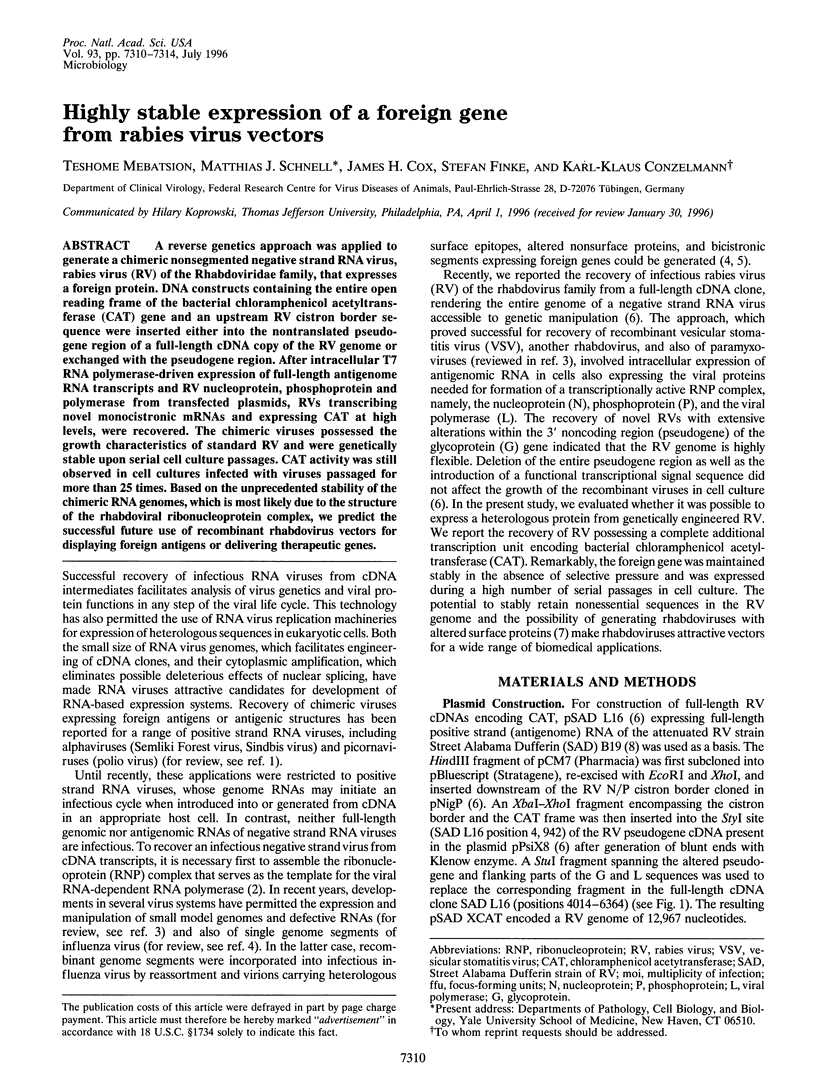
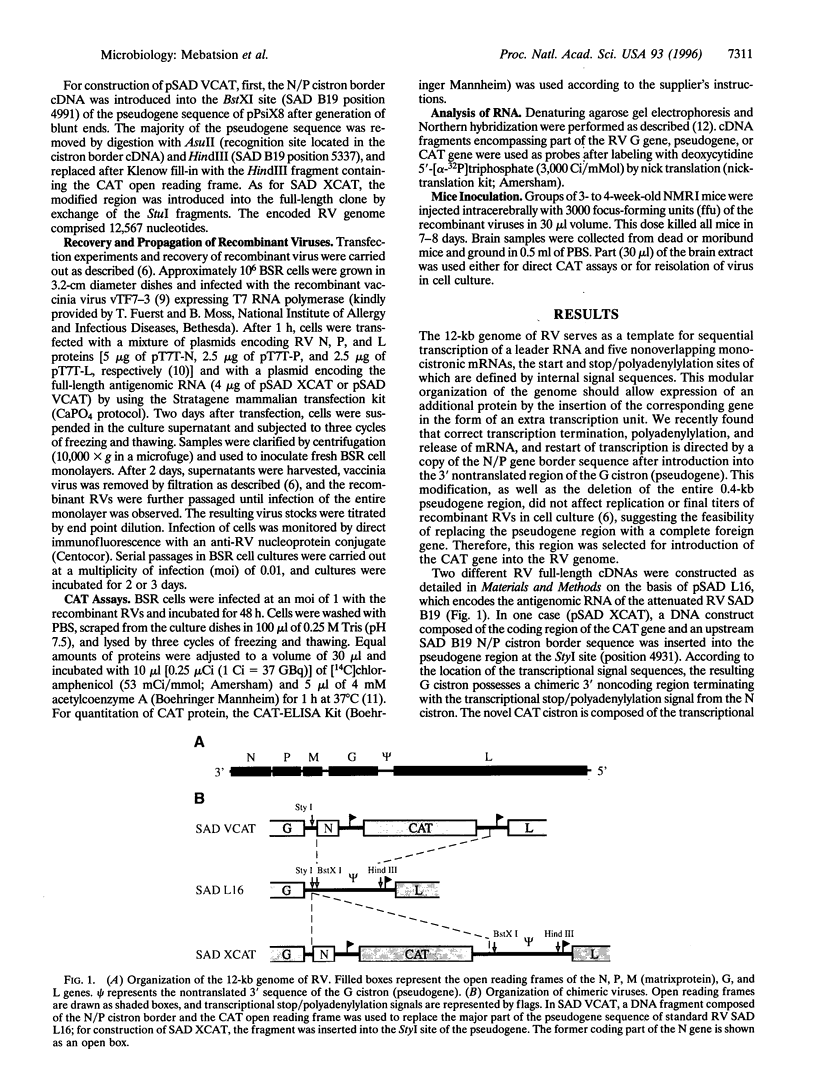

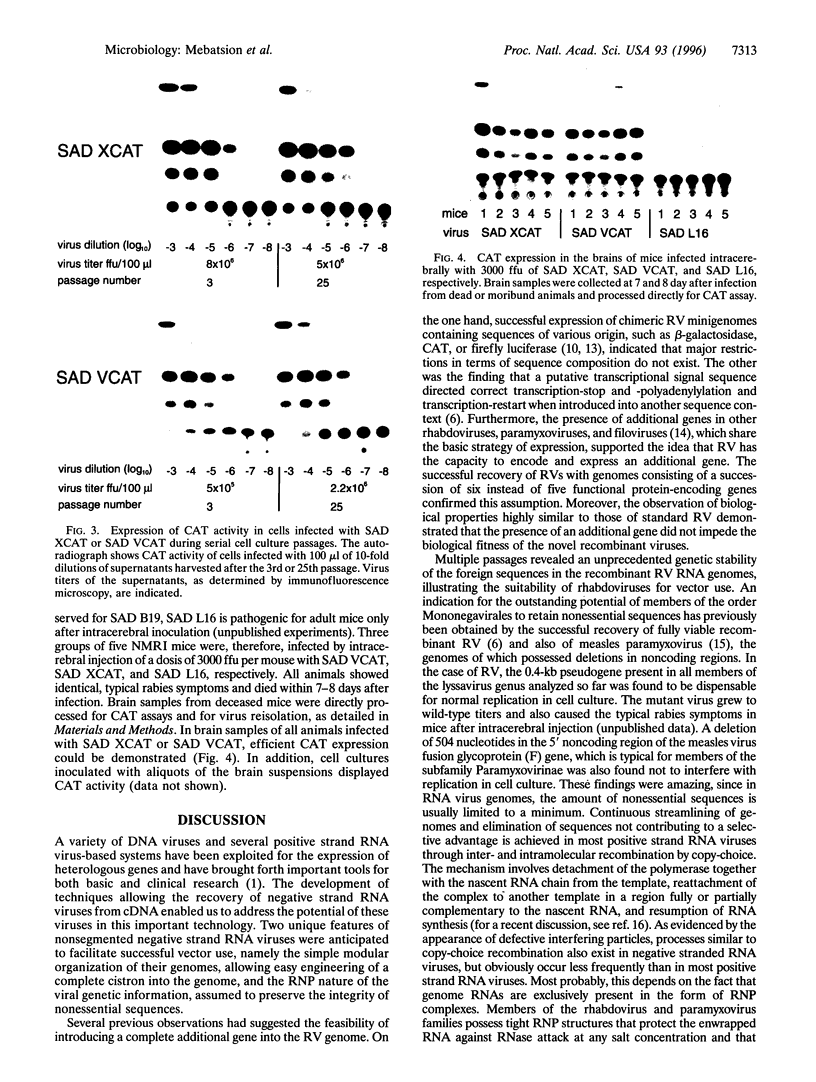

Images in this article
Selected References
These references are in PubMed. This may not be the complete list of references from this article.
- Andino R., Silvera D., Suggett S. D., Achacoso P. L., Miller C. J., Baltimore D., Feinberg M. B. Engineering poliovirus as a vaccine vector for the expression of diverse antigens. Science. 1994 Sep 2;265(5177):1448–1451. doi: 10.1126/science.8073288. [DOI] [PubMed] [Google Scholar]
- Baudin F., Bach C., Cusack S., Ruigrok R. W. Structure of influenza virus RNP. I. Influenza virus nucleoprotein melts secondary structure in panhandle RNA and exposes the bases to the solvent. EMBO J. 1994 Jul 1;13(13):3158–3165. doi: 10.1002/j.1460-2075.1994.tb06614.x. [DOI] [PMC free article] [PubMed] [Google Scholar]
- Calain P., Roux L. The rule of six, a basic feature for efficient replication of Sendai virus defective interfering RNA. J Virol. 1993 Aug;67(8):4822–4830. doi: 10.1128/jvi.67.8.4822-4830.1993. [DOI] [PMC free article] [PubMed] [Google Scholar]
- Conzelmann K. K., Cox J. H., Schneider L. G., Thiel H. J. Molecular cloning and complete nucleotide sequence of the attenuated rabies virus SAD B19. Virology. 1990 Apr;175(2):485–499. doi: 10.1016/0042-6822(90)90433-r. [DOI] [PubMed] [Google Scholar]
- Conzelmann K. K., Cox J. H., Thiel H. J. An L (polymerase)-deficient rabies virus defective interfering particle RNA is replicated and transcribed by heterologous helper virus L proteins. Virology. 1991 Oct;184(2):655–663. doi: 10.1016/0042-6822(91)90435-e. [DOI] [PubMed] [Google Scholar]
- Conzelmann K. K. Genetic manipulation of non-segmented negative-strand RNA viruses. J Gen Virol. 1996 Mar;77(Pt 3):381–389. doi: 10.1099/0022-1317-77-3-381. [DOI] [PubMed] [Google Scholar]
- Conzelmann K. K., Schnell M. Rescue of synthetic genomic RNA analogs of rabies virus by plasmid-encoded proteins. J Virol. 1994 Feb;68(2):713–719. doi: 10.1128/jvi.68.2.713-719.1994. [DOI] [PMC free article] [PubMed] [Google Scholar]
- Emerson S. U., Wagner R. R. Dissociation and reconstitution of the transcriptase and template activities of vesicular stomatitis B and T virions. J Virol. 1972 Aug;10(2):297–309. doi: 10.1128/jvi.10.2.297-309.1972. [DOI] [PMC free article] [PubMed] [Google Scholar]
- Fuerst T. R., Niles E. G., Studier F. W., Moss B. Eukaryotic transient-expression system based on recombinant vaccinia virus that synthesizes bacteriophage T7 RNA polymerase. Proc Natl Acad Sci U S A. 1986 Nov;83(21):8122–8126. doi: 10.1073/pnas.83.21.8122. [DOI] [PMC free article] [PubMed] [Google Scholar]
- Garcin D., Pelet T., Calain P., Roux L., Curran J., Kolakofsky D. A highly recombinogenic system for the recovery of infectious Sendai paramyxovirus from cDNA: generation of a novel copy-back nondefective interfering virus. EMBO J. 1995 Dec 15;14(24):6087–6094. doi: 10.1002/j.1460-2075.1995.tb00299.x. [DOI] [PMC free article] [PubMed] [Google Scholar]
- García-Sastre A., Palese P. Influenza virus vectors. Biologicals. 1995 Jun;23(2):171–178. doi: 10.1006/biol.1995.0028. [DOI] [PubMed] [Google Scholar]
- Gorman C. M., Moffat L. F., Howard B. H. Recombinant genomes which express chloramphenicol acetyltransferase in mammalian cells. Mol Cell Biol. 1982 Sep;2(9):1044–1051. doi: 10.1128/mcb.2.9.1044. [DOI] [PMC free article] [PubMed] [Google Scholar]
- Heggeness M. H., Scheid A., Choppin P. W. the relationship of conformational changes in the Sendai virus nucleocapsid to proteolytic cleavage of the NP polypeptide. Virology. 1981 Oct 30;114(2):555–562. doi: 10.1016/0042-6822(81)90235-x. [DOI] [PubMed] [Google Scholar]
- Khatchikian D., Orlich M., Rott R. Increased viral pathogenicity after insertion of a 28S ribosomal RNA sequence into the haemagglutinin gene of an influenza virus. Nature. 1989 Jul 13;340(6229):156–157. doi: 10.1038/340156a0. [DOI] [PubMed] [Google Scholar]
- Lawson N. D., Stillman E. A., Whitt M. A., Rose J. K. Recombinant vesicular stomatitis viruses from DNA. Proc Natl Acad Sci U S A. 1995 May 9;92(10):4477–4481. doi: 10.1073/pnas.92.10.4477. [DOI] [PMC free article] [PubMed] [Google Scholar]
- Lazzarini R. A., Keene J. D., Schubert M. The origins of defective interfering particles of the negative-strand RNA viruses. Cell. 1981 Oct;26(2 Pt 2):145–154. doi: 10.1016/0092-8674(81)90298-1. [DOI] [PubMed] [Google Scholar]
- Li S., Polonis V., Isobe H., Zaghouani H., Guinea R., Moran T., Bona C., Palese P. Chimeric influenza virus induces neutralizing antibodies and cytotoxic T cells against human immunodeficiency virus type 1. J Virol. 1993 Nov;67(11):6659–6666. doi: 10.1128/jvi.67.11.6659-6666.1993. [DOI] [PMC free article] [PubMed] [Google Scholar]
- Lynch S., Kolakofsky D. Ends of the RNA within Sendai virus defective interfering nucleocapsids are not free. J Virol. 1978 Nov;28(2):584–589. doi: 10.1128/jvi.28.2.584-589.1978. [DOI] [PMC free article] [PubMed] [Google Scholar]
- Mebatsion T., Konig M., Conzelmann K. K. Budding of rabies virus particles in the absence of the spike glycoprotein. Cell. 1996 Mar 22;84(6):941–951. doi: 10.1016/s0092-8674(00)81072-7. [DOI] [PubMed] [Google Scholar]
- Mebatsion T., Schnell M. J., Conzelmann K. K. Mokola virus glycoprotein and chimeric proteins can replace rabies virus glycoprotein in the rescue of infectious defective rabies virus particles. J Virol. 1995 Mar;69(3):1444–1451. doi: 10.1128/jvi.69.3.1444-1451.1995. [DOI] [PMC free article] [PubMed] [Google Scholar]
- Meyers G., Rümenapf T., Tautz N., Dubovi E. J., Thiel H. J. Insertion of cellular sequences in the genome of bovine viral diarrhea virus. Arch Virol Suppl. 1991;3:133–142. doi: 10.1007/978-3-7091-9153-8_15. [DOI] [PubMed] [Google Scholar]
- Meyers G., Rümenapf T., Thiel H. J. Ubiquitin in a togavirus. Nature. 1989 Oct 12;341(6242):491–491. doi: 10.1038/341491a0. [DOI] [PubMed] [Google Scholar]
- Radecke F., Spielhofer P., Schneider H., Kaelin K., Huber M., Dötsch C., Christiansen G., Billeter M. A. Rescue of measles viruses from cloned DNA. EMBO J. 1995 Dec 1;14(23):5773–5784. doi: 10.1002/j.1460-2075.1995.tb00266.x. [DOI] [PMC free article] [PubMed] [Google Scholar]
- Schnell M. J., Buonocore L., Whitt M. A., Rose J. K. The minimal conserved transcription stop-start signal promotes stable expression of a foreign gene in vesicular stomatitis virus. J Virol. 1996 Apr;70(4):2318–2323. doi: 10.1128/jvi.70.4.2318-2323.1996. [DOI] [PMC free article] [PubMed] [Google Scholar]
- Schnell M. J., Conzelmann K. K. Polymerase activity of in vitro mutated rabies virus L protein. Virology. 1995 Dec 20;214(2):522–530. doi: 10.1006/viro.1995.0063. [DOI] [PubMed] [Google Scholar]
- Schnell M. J., Mebatsion T., Conzelmann K. K. Infectious rabies viruses from cloned cDNA. EMBO J. 1994 Sep 15;13(18):4195–4203. doi: 10.1002/j.1460-2075.1994.tb06739.x. [DOI] [PMC free article] [PubMed] [Google Scholar]
- Wertz G. W., Whelan S., LeGrone A., Ball L. A. Extent of terminal complementarity modulates the balance between transcription and replication of vesicular stomatitis virus RNA. Proc Natl Acad Sci U S A. 1994 Aug 30;91(18):8587–8591. doi: 10.1073/pnas.91.18.8587. [DOI] [PMC free article] [PubMed] [Google Scholar]
- Whelan S. P., Ball L. A., Barr J. N., Wertz G. T. Efficient recovery of infectious vesicular stomatitis virus entirely from cDNA clones. Proc Natl Acad Sci U S A. 1995 Aug 29;92(18):8388–8392. doi: 10.1073/pnas.92.18.8388. [DOI] [PMC free article] [PubMed] [Google Scholar]




